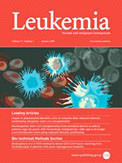Žaliová M, Madžo J, Cario G, Trka J. Leukemia. 2010 Nov 26. IF: 8.296

Abstract:
Translocation (12;21), the most frequent chromosomal aberration in childhood acute lymphoblastic leukemia, creates TEL/AML1 fusion gene. Resulting hybrid protein was shown to have a role in pre-leukemia establishment. To address its role for leukemic cell survival, we applied RNA interference to silence TEL/AML1 in leukemic cells. We designed and tested 11 different oligonucleotides targeting the TEL/AML1 fusion site. Using most efficient siRNAs, we achieved an average of 74–86 % TEL/AML1 protein knockdown in REH and UOC-B6 leukemic cells, respectively. TEL/AML1 silencing neither decreased cell viability, nor induced apoptosis. On the contrary, it resulted in the modest but significant increase in the S phase fraction and in higher proliferation rate. Opposite effects on cell cycle distribution and proliferation were induced by AML1 silencing, thus, supporting our hypothesis that TEL/AML1 may block AML1-mediated promotion of G1/S progression through the cell cycle. In line with the lack of major effect on phenotype, we found no significant changes in clonogenic potential and global gene expression pattern upon TEL/AML1 depletion. Our data suggest that though TEL/AML1 is important for the (pre)leukemic clone development, it may be dispensable for leukemic cell survival and would not be a suitable target for gene-specific therapy.
-az-